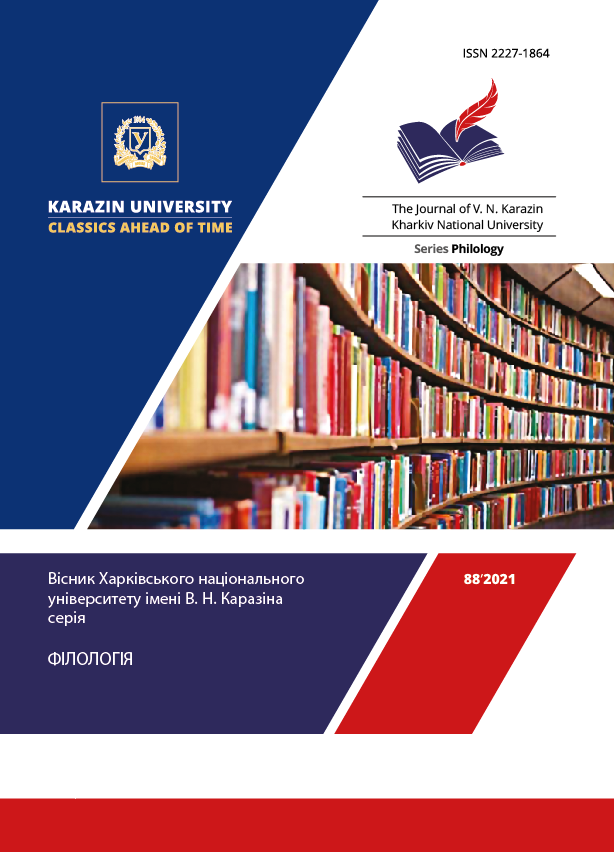Associative connections of stimuli PEACE and WAR: semantic content (on the material of a chain associative experiment with humanities students)
Abstract
The paper is devoted to the study of the associative relations of the lexemes PEACE and WAR. The aim of the work is to reveal the cultural component of the associative fields of the stimulus words PEACE and WAR. Due to the object of study (the associative connections of stimuli PEACE and WAR in the linguistic consciousness of humanities students) we consider the usage of associative psycholinguistic experiment to be the most appropriate, because the object cannot be observed directly. The paper outlines the methodological grounds for such study. The material for the article was the associative reactions obtained during the experiment with humanities students. On the basis of the received data the quantitative, mathematical and qualitative analyses of semantic content of associative fields of stimuli PEACE and WAR are realized. The analysis showed that the mutual influence of culture and language is reflected in the associative content of these stimuli, and hence in the linguistic consciousness in which such connections are contained. It is concluded that students receive certain cultural codes from the experience of their nation through language, as they are embodied in language signs. This fact demonstrates that a person is both an object and a subject of culture. The obtained reactions suggest that linguistic culture has greater impact on associative connections than individual, personal experience. It is impossible to deny the influence of ethnic factors on the worldview and the formation of consciousness of a particular linguistic and cultural community. The PEACE and WAR associations presents an inseparable connection between them in the linguistic and cultural consciousness of humanities students and they can exist only in opposition to each other.
Downloads
References
Halunova, N. Savchuk, E., (2018). Osoblyvosti spryiniattia koloropoznachen u movnii kartyni svitu anhlomovnykh predstavnykiv serednoho viku [The Specifics of the Perception of the Names of Colours in the Language World Model of English-speaking Middle-aged Representatives]. Visnyk Kharkivskoho natsionalnoho universytetu imeni V. N. Karazina. Seriia: Filolohiia, 78, 185–188. Kharkiv. Retrieved September 26, 2020, from http://nbuv.gov.ua/UJRN/VKhIFL_2018_78_39
Domnich, O., (2019). Natsionalno-kulturnyi kod u linhvistychnii paradyhmi znannia. Movni i kontseptualni kartyny svitu. № 66(2), 42–55. Retrieved September 26, 2020, from http://nbuv.gov.ua/UJRN/Mikks_2019_66(2)__8.
Maslova, V., (2001) Lynhvokulturolohyia: Ucheb. posobye dlia stud. vyssh. ucheb. zavedenyi. Moskva: Yzdatelskyi tsentr «Akademyia». [in Russian]
Mykhailova, M., (2011). Etnokulturna ta natsionalna svidomist: sotsialno-filosofskyi analiz. Naukovi zapysky Natsionalnoho universytetu «Ostrozka akademiia». Ser.: Filosofiia, № 8, 19–27. Retrieved September 26, 2020, from http://nbuv.gov.ua/UJRN/Nznuoafs_2011_8_5.
Panina, N. (2001). Tehnologiya sociologicheskogo issledovaniya [Technology of social study]. Kyiv: In-t sociolohii NAN Ukrainy. [in Russian]
Poliarenko, V., (2015). Mova i kultura: vzaiemodiia ta spivisnuvannia. Rysy kharakteru ukrainskoho narodu yak skladova natsionalnoi kultury. Molodyi vchenyi. № 5 (3), 8–10. Retrieved September 26, 2020, from http://nbuv.gov.ua/UJRN/molv_2015_5(3)__3
Skrypnyk, N., (2011) Zviazok movy y myslennia yak osnova kontseptualnoho analizu. Naukovyi chasopys Natsionalnoho pedahohichnoho universytetu imeni M. P. Drahomanova. Seriia 10: Problemy hramatyky i leksykolohii ukrainskoi movy. № 7, 416–418. Retrieved September 26, 2020, from http://nbuv.gov.ua/UJRN/Nchnpu_10_2011_7_94.
Slovnyk ukrainskoi movy: v 11 tomakh. Tom 4 (1973).
Suimenko, Y. (n.d.). Anketne opytuvannia: mystetstvo stavyty zapytannia [A questionnaire based survey: the art of asking questions]. Retrieved September 26, 2020, from https://divovo.in.ua/anketne-opituvannya-mistectvo-staviti-zapitannya.html [in Ukrainian]
Boiarova, L., Kalashnyk, V. (Eds). (2005). Tlumachnyi slovnyk ukrainskoi movy. Prapor.
Burgess, T. (2001) Information Systems Services. Guide to the Design of Questionnaires. A general introduction to the design of questionnaires for survey research. University of Leeds.
Krosnick, J. A. and Presser, S. (2009) Question and Questionnaire Design. Handbook of Survey Research (2nd Edition). James D. Wright and Peter V. Marsden (Eds). San Diego, CA: Elsevier.
Nelson, D., McEvoy, C., & Dennis, S. (2012). What is and what does free association measure? Memory & Cognition. doi: 10.3758/BF03209337




